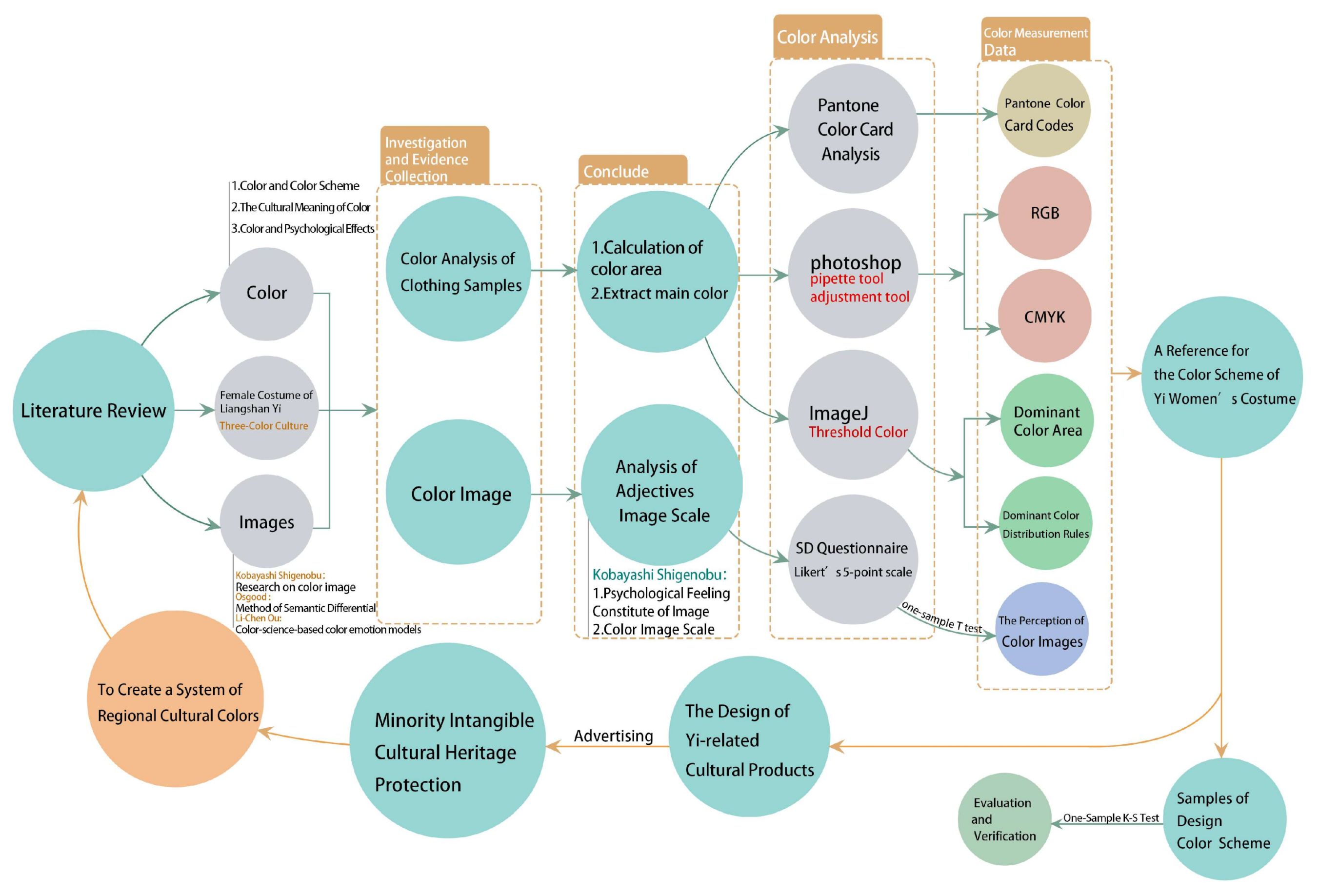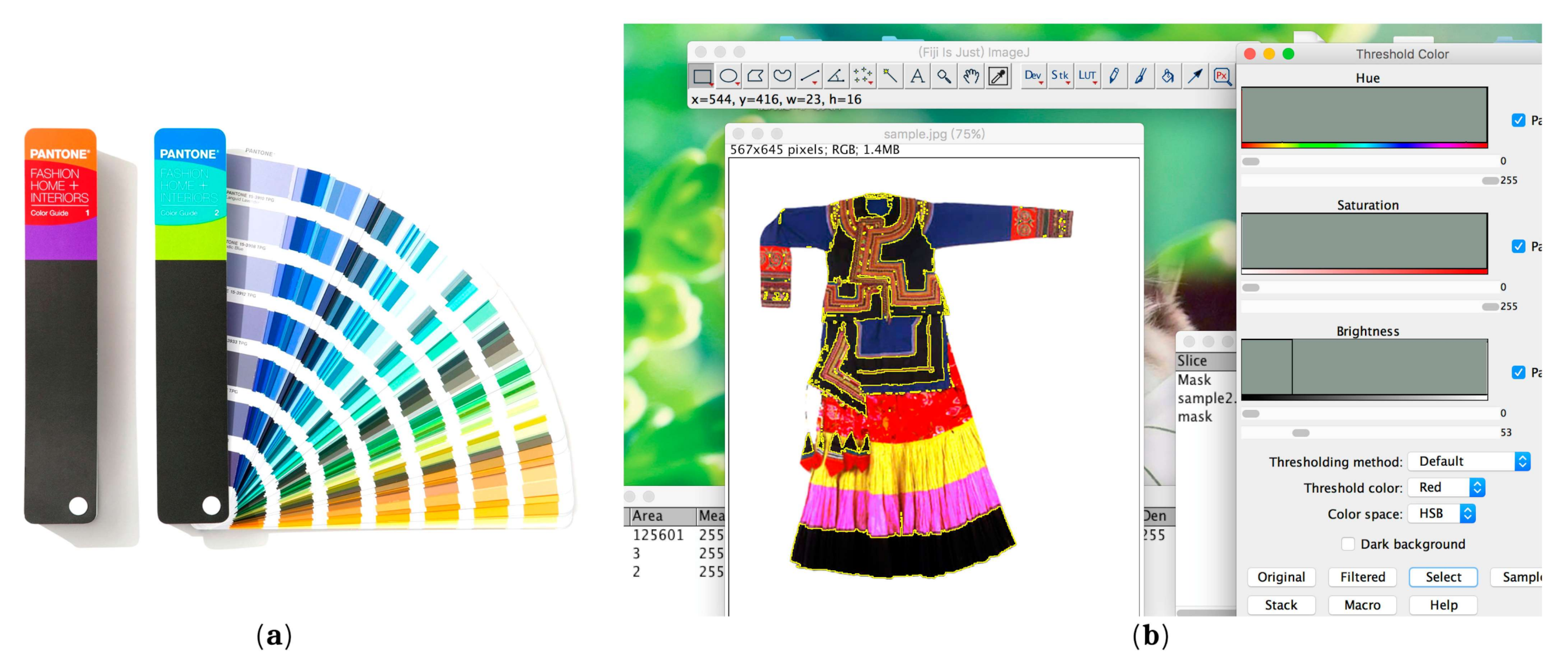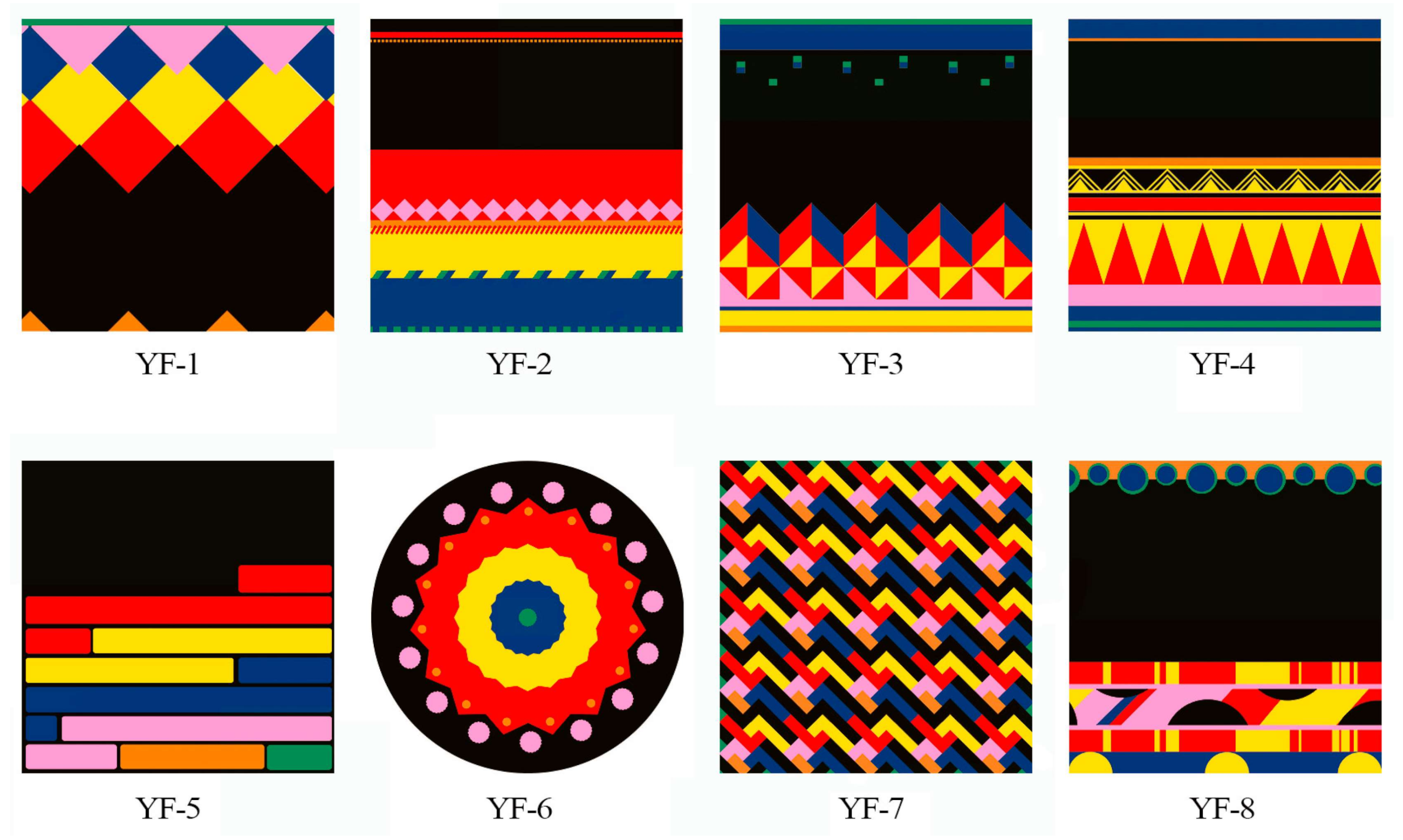Design Mode Innovation of Local Color Cultures: A Case Study of the Traditional Female Costume of Yi Nationality
Abstract
:1. Introduction
2. Literature Review
2.1. Color and Culture
2.2. Female Costume of Liangshan Yi
2.3. Visual Images
3. Methods
3.1. Data Collection
3.1.1. Color Analysis
3.1.2. Color Images
3.1.3. Color Scheme Sample Design
3.1.4. Color Scheme Sample Verification
3.2. Liangshan Yi
4. Results
4.1. Color Analysis
4.1.1. Color Area Analysis
4.1.2. Color Distribution
4.2. Color Images
4.2.1. Image Adjectives Collection
4.2.2. Color Image Survey
4.3. Sample Design of Color Scheme
4.3.1. Color Images
4.3.2. Instructions for Color Scheme
- Color area ratio: dominant color, black 37%. Secondary colors, red, 15%; yellow, 15%; blue, 14%; and pink, 12%. Decorative colors: orange, 5% and green, 2%.
- Principles of color scheme: large areas of color black; areas of blue; yellow, red and pink stripes for emphasis; green, orange lines and lines in other decorative colors repeatedly embellished on the edge.
4.4. Verification on Color Scheme Samples
5. Conclusions
- Understand color characteristics. Through knowing and understanding culture, analyze the color samples in a scientific way, define the standard color of the culture, and summarize the color attributes and characteristics unique to the culture.
- Analysis of color images. Culture of different regions has its own characteristics and symbols. Through the psychological experiment of images, understand the perception that the colors of a certain culture convey to people and make it the basis for criteria of color scheme.
- Establish color scheme samples. Summarize and organize the records of color, ask designers to assist in establishing color scheme samples and evaluate the effectiveness of such samples.
- Principles of color scheme. Establish comprehensive color scheme principles as a basis for promoting and advertising regional cultural colors.
- The colors of costume usually change with the times, mainly because the materials obtained are different due to environmental reasons. Therefore, the colors used by costume makers can be slightly different. In the early 1950s, most areas in Liangshan were still a slave society which was ended in 1956. After that, Liangshan entered socialist society. The samples used in this research are based on the color scheme of Liangshan Yi women’s daily costume after 1956, and that before 1956 is not taken into consideration in this study.
- According to mere exposure proposed by Robert Zajonc in 1968, the more common a stimulus is, whether it is a figure or a human face, the more people will like it, meaning the frequency of the stimulus is positively correlated with the degree of people’s preference. Therefore, this study only discusses the colors on the front side of the costume without taking headwear, necklaces and other accessories into consideration [41].
Author Contributions
Funding
Conflicts of Interest
References
- UNESCO. Convention on the Protection and Promotion of the Diversity of Cultural Expressions. Available online: https://en.unesco.org/creativity/convention/texts (accessed on 10 April 2018).
- Guangli, W. Research on the Art of Patterns on Yi Nationality’s Costume; Kunming University of Science and Technology: Kunming, China, 2007. [Google Scholar]
- Ning, S.; Qinchuan, Z. On the Integration of National Costume Elements and Modern Costume Design. In Proceedings of the International Conference on Information Technology and Career Education, Beijing, China, 29–30 September 2013; p. 02013. [Google Scholar]
- Xiao-ran, F. Influence of National Costume on Fashion. Chem. Fiber Text. Technol. 2012, 2, 11. [Google Scholar]
- Bakieva, O.; Popova, O. Features of color mentality of the indigenous small nationalities of the Arctic (on the example of the analysis of the traditional Khanty people costume). In Proceedings of the IOP Conference Series: Earth and Environmental Science, Saint Petersburg, Russia, 17–18 April 2019; p. 012157. [Google Scholar]
- Juan, L. Analyze Traditional Chinese Border and National Costume Design. Tianjin Text. Sci. Technol. 2006, 3, 10. [Google Scholar]
- Lenclos, J.-P.; Lenclos, D. Colors of the World: The Geography of Color; WW Norton & Company: New York, NY, USA, 2004. [Google Scholar]
- Singh, S. Impact of color on marketing. Manag. Decis. 2006, 44, 783–789. [Google Scholar] [CrossRef]
- Fairchild, M.D. Color Appearance Models; John Wiley & Sons, Inc.: Hoboken, NJ, USA, 2013. [Google Scholar]
- Tsuneo, K. Principles of Color; Rikoh Tosho: Tokyo, Japan, 1969. [Google Scholar]
- Jiang, Q.; Chen, L.-C.; Zhang, J. Perception and Preference Analysis of Fashion Colors: Solid Color Shirts. Sustainability 2019, 11, 2405. [Google Scholar] [CrossRef] [Green Version]
- Hillenbrand, P.; Alcauter, S.; Cervantes, J.; Barrios, F. Better branding: Brand names can influence consumer choice. J. Prod. Brand Manag. 2013, 22, 300–308. [Google Scholar] [CrossRef]
- Choi, H.H.; Lim, S.A.; HeeKim, J. Promotional Video of Editing Techniques Utilizing Color and Brand Balance. Int. J. Softw. Eng. Appl. 2014, 8, 149–158. [Google Scholar]
- Miller-Spillman, K.A.; Kimberly, A.; Reilly, A. The Meanings of Dress; Fairchild Books: New York, NY, USA, 2019. [Google Scholar]
- Yang, Y. On Color Signs of Yi Ethnic Group in Liangshan. Beauty Times 2015, 7, 135–136. [Google Scholar] [CrossRef]
- Zhong, S.; Zhou, W. The Yi Nationality’s Costumes and Ornaments in China; Yunnan Fine Arts Publishing House: Kunming, China, 2006. [Google Scholar]
- Zhang, L. On Dominant Elements of Yi Nationality’s Costume Patterns. J. Southwest Univ. Natl. (Humanit. Soc. Sci.) 2014, 7, 45–48. [Google Scholar] [CrossRef]
- Wu, H. The Costume of the Yi Women in Liangshan. Art Panor. 2007, 10, 18–19. [Google Scholar] [CrossRef]
- Lamb, T.; Bourriau, J. Colour: Art and Science; Cambridge University Press: Cambridge, UK, 1995; Volume 7. [Google Scholar]
- McKellar, P. The Investigation of Mental Images; Penguin Books: London, UK, 1965. [Google Scholar]
- Osgood, C.E.; Suci, G.J.; Tannenbaum, P.H. The Measurement of Meaning; University of Illinois Press: Champaign, IL, USA, 1957. [Google Scholar]
- Kobayashi, S. The aim and method of the color image scale. Color Res. Appl. 1981, 6, 93–107. [Google Scholar] [CrossRef]
- Garth, T.R. The Color Preferences of Five Hundred and Fifty-Nine Full-Blood Indians. J. Exp. Psychol. 1922, 5, 392. [Google Scholar] [CrossRef] [Green Version]
- Choungourian, A. Color preferences and cultural variation. Percept. Mot. Ski. 1968, 26, 1203–1206. [Google Scholar] [CrossRef]
- Ou, L.C.; Ronnier Luo, M.; Sun, P.L.; Hu, N.C.; Chen, H.S.; Guan, S.S.; Woodcock, A.; Caivano, J.L.; Huertas, R.; Treméau, A. A cross-cultural comparison of colour emotion for two-colour combinations. Color Res. Appl. 2012, 37, 23–43. [Google Scholar] [CrossRef]
- Ou, L.C.; Luo, M.R.; Sun, P.L.; Hu, N.C.; Chen, H.S. Age effects on colour emotion, preference, and harmony. Color Res. Appl. 2012, 37, 92–105. [Google Scholar] [CrossRef]
- Hurlbert, A.C.; Ling, Y. Biological components of sex differences in color preference. Curr. Biol. 2007, 17, R623–R625. [Google Scholar] [CrossRef] [Green Version]
- Schloss, K.B.; Poggesi, R.M.; Palmer, S.E. Effects of university affiliation and “school spirit” on color preferences: Berkeley versus Stanford. Psychon. Bull. Rev. 2011, 18, 498–504. [Google Scholar] [CrossRef]
- Ou, L.C.; Luo, M.R.; Woodcock, A.; Wright, A. A study of colour emotion and colour preference. Part I: Colour emotions for single colours. Color Res. Appl. 2004, 29, 232–240. [Google Scholar] [CrossRef]
- Shigenobu, K. Psychology on Pattern Formation; Kabushiki Kaisha Daviddosha: Tokyo, Japan, 2002. [Google Scholar]
- Kobayashi, S. Color Image Scale. 2009. Available online: http://www.ncd-ri.co.jp/english/main_0104.html (accessed on 20 May 2019).
- Hsu, M.Y.; Ou, L.C.; Guan, S.S. Colour preference for Taiwanese floral pattern fabrics. Color Res. Appl. 2016, 41, 43–55. [Google Scholar] [CrossRef]
- Liu, J.; Lughofer, E.; Zeng, X. Could linear model bridge the gap between low-level statistical features and aesthetic emotions of visual textures? Neurocomputing 2015, 168, 947–960. [Google Scholar] [CrossRef]
- Xin, J.H.; Cheng, K.; Taylor, G.; Sato, T.; Hansuebsai, A. Cross-regional comparison of colour emotions Part I: Quantitative analysis. Color Res. Appl. 2004, 29, 451–457. [Google Scholar] [CrossRef]
- Sato, T.K.K.; Hoshino, H.; Nakamura, T. Quantitative evaluation and categorising of human emotion induced by colour. Adv. Colour Sci. Technol. 2000, 3, 53–59. [Google Scholar]
- Thumfart, S.; Jacobs, R.H.; Lughofer, E.; Eitzinger, C.; Cornelissen, F.W.; Groissboeck, W.; Richter, R. Modeling human aesthetic perception of visual textures. ACM Trans. Appl. Percept. (TAP) 2008, 8, 1–29. [Google Scholar] [CrossRef]
- Lee, W.Y.; Pai, S.Y. The affective feelings of colored typefaces. Color Res. Appl. 2012, 37, 367–374. [Google Scholar] [CrossRef]
- Ou, L.C.; Luo, M.R.; Woodcock, A.; Wright, A. A study of colour emotion and colour preference. part II: Colour emotions for two-colour combinations. Color Res. Appl. 2004, 29, 292–298. [Google Scholar] [CrossRef]
- Wu, M.; Tu, J. SPSS & The Application and Analysis of Statistics; Wu-Nan Book: Taipei, Taiwan, 2016. [Google Scholar]
- Justel, A.; Peña, D.; Zamar, R. A multivariate Kolmogorov-Smirnov test of goodness of fit. Stat. Probab. Lett. 1997, 35, 251–259. [Google Scholar] [CrossRef] [Green Version]
- Zajonc, R.B. Mere exposure: A gateway to the subliminal. Curr. Dir. Psychol. Sci. 2001, 10, 224–228. [Google Scholar] [CrossRef]




| Color Scheme | Color | Pixel Area | Color Ratio | RGB | CMYK | Pantone |
|---|---|---|---|---|---|---|
| Dominant Color | Black | 467,161 | 37% | 18/13/2 | 84%, 82%, 92%, 74% | 19–4006 |
| Secondary Colors | Red | 188,193 | 15% | 226/4/0 | 13%, 93%, 100%, 0% | 18–1763 |
| Yellow | 183,223 | 15% | 255/222/29 | 7%, 10%, 73%, 0% | 13–0858 | |
| Blue | 171,140 | 14% | 0/56/120 | 91%, 86%, 21%, 0% | 18–4434 | |
| Pink | 153,445 | 12% | 255/156/210 | 7%, 50%, 0%, 0% | 15–2213 | |
| Decorative Colors | Orange | 62,803 | 5% | 242/134/39 | 5%, 60%, 86%, 0% | 15–1263 |
| Green | 30,089 | 2% | 9/140/86 | 82%, 31%, 82%, 0% | 17–6030 |
| English |
|---|
| Traditional-Modern |
| Splendid-Plain |
| Festive-Sorrowful |
| Complex-Simple |
| Heavy-Light |
| Passionate-Indifferent |
| Unique-Common |
| Hard-Soft |
| Image Verification | Mean | t | Sig. (2-Tailed) |
|---|---|---|---|
| Traditional-Modern | 1.76 | −13.662 | 0.000 *** |
| Splendid-Plain | 2.74 | −2.061 | 0.042 * |
| Festive-Sorrowful | 1.88 | −13.817 | 0.000 *** |
| Complex-Simple | 1.83 | −12.176 | 0.000 *** |
| Heavy-Light | 1.90 | −12.054 | 0.000 *** |
| Passionate-Indifferent | 1.89 | −12.246 | 0.000 *** |
| Unique-Common | 2.30 | −5.978 | 0.000 *** |
| Hard-Soft | 2.07 | −10.041 | 0.000 *** |
| YF-1 | YF-2 | ||||||||||||||||
|---|---|---|---|---|---|---|---|---|---|---|---|---|---|---|---|---|---|
| Image Evaluation Project | Traditional | Splendid | Festive | Complex | Heavy | Passionate | Unique | Hard | Traditional | Splendid | Festive | Complex | Heavy | Passionate | Unique | Hard | |
| Most Extreme Differences | Positive | 0.146 | 0.149 | 0.176 | 0.145 | 0.163 | 0.131 | 0.187 | 0.122 | 0.134 | 0.179 | 0.185 | 0.165 | 0.152 | 0.16 | 0.161 | 0.142 |
| Negative | −0.38 | −0.33 | −0.434 | −0.33 | −0.354 | −0.352 | −0.417 | −0.383 | −0.331 | −0.372 | −0.377 | −0.385 | −0.375 | −0.371 | −0.365 | −0.356 | |
| Asymp. Sig. (2-tailed) | 0.000 *** | 0.000 *** | 0.000 *** | 0.000 *** | 0.000 *** | 0.000 *** | 0.000 *** | 0.000 *** | 0.000 *** | 0.000 *** | 0.000 *** | 0.000 *** | 0.000 *** | 0.000 *** | 0.000 *** | 0.000 *** | |
| YF-3 | YF-4 | ||||||||||||||||
| Most Extreme Differences | Positive | 0.234 | 0.179 | 0.179 | 0.149 | 0.165 | 0.195 | 0.165 | 0.165 | 0.104 | 0.165 | 0.173 | 0.148 | 0.152 | 0.175 | 0.159 | 0.15 |
| Negative | −0.329 | −0.415 | −0.393 | −0.336 | −0.397 | −0.422 | −0.417 | −0.389 | −0.371 | −0.352 | −0.359 | −0.368 | −0.372 | −0.377 | −0.391 | −0.403 | |
| Asymp. Sig. (2-tailed) | 0.000 *** | 0.000 *** | 0.000 *** | 0.000 *** | 0.000 *** | 0.000 *** | 0.000 *** | 0.000 *** | 0.000 *** | 0.000 *** | 0.000 *** | 0.000 *** | 0.000 *** | 0.000 *** | 0.000 *** | 0.000 *** | |
| YF-5 | YF-6 | ||||||||||||||||
| Most Extreme Differences | Positive | 0.259 | 0.195 | 0.214 | 0.167 | 0.182 | 0.173 | 0.199 | 0.187 | 0.142 | 0.153 | 0.139 | 0.124 | 0.174 | 0.133 | 0.141 | 0.113 |
| Negative | −0.342 | −0.379 | −0.402 | −0.301 | −0.393 | −0.391 | −0.385 | −0.34 | −0.323 | −0.366 | −0.399 | −0.4 | −0.345 | −0.404 | −0.324 | −0.382 | |
| Asymp. Sig. (2-tailed) | 0.000 *** | 0.000 *** | 0.000 *** | 0.000 *** | 0.000 *** | 0.000 *** | 0.000 *** | 0.000 *** | 0.000 *** | 0.000 *** | 0.000 *** | 0.000 *** | 0.000 *** | 0.000 *** | 0.000 *** | 0.000 *** | |
| YF−7 | YF−8 | ||||||||||||||||
| Most Extreme Differences | Positive | 0.273 | 0.148 | 0.16 | 0.116 | 0.15 | 0.109 | 0.142 | 0.124 | 0.239 | 0.18 | 0.188 | 0.166 | 0.211 | 0.161 | 0.194 | 0.185 |
| Negative | −0.365 | −0.368 | −0.356 | −0.379 | −0.354 | −0.358 | −0.323 | −0.392 | −0.357 | −0.401 | −0.384 | −0.355 | −0.427 | −0.387 | −0.402 | −0.397 | |
| Asymp. Sig. (2-tailed) | 0.000 *** | 0.000 *** | 0.000 *** | 0.000 *** | 0.000 *** | 0.000 *** | 0.000 *** | 0.000 *** | 0.000 *** | 0.000 *** | 0.000 *** | 0.000 *** | 0.000 *** | 0.000 *** | 0.000 *** | 0.000 *** | |
Publisher’s Note: MDPI stays neutral with regard to jurisdictional claims in published maps and institutional affiliations. |
© 2020 by the authors. Licensee MDPI, Basel, Switzerland. This article is an open access article distributed under the terms and conditions of the Creative Commons Attribution (CC BY) license (http://creativecommons.org/licenses/by/4.0/).
Share and Cite
Ji, Z.; Huang, W.-H.; Lin, M. Design Mode Innovation of Local Color Cultures: A Case Study of the Traditional Female Costume of Yi Nationality. Designs 2020, 4, 56. https://doi.org/10.3390/designs4040056
Ji Z, Huang W-H, Lin M. Design Mode Innovation of Local Color Cultures: A Case Study of the Traditional Female Costume of Yi Nationality. Designs. 2020; 4(4):56. https://doi.org/10.3390/designs4040056
Chicago/Turabian StyleJi, Zhe, Wei-Hsin Huang, and Mengyi Lin. 2020. "Design Mode Innovation of Local Color Cultures: A Case Study of the Traditional Female Costume of Yi Nationality" Designs 4, no. 4: 56. https://doi.org/10.3390/designs4040056




